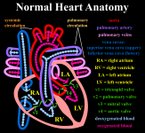A 40 year-old male presented to the emergency department with fever and mental status changes. Diagnostic evaluation revealed a brain abscess of uncertain etiology. The patient was known to have a complex uncorrected congenital heart condition, the details of which were incompletely understood.
The patient underwent cardiac MRI examination to further evaluate anatomy and function. Axial black blood Tl weighted images of the chest confirmed dextrocardia (Figure 1) with a single ventricle, situs solitus, and two atrioventricular valves. The patient had transposition of his aorta and pulmonary artery (Figure 2; curved arrow: main pulmonary artery; straight arrow: aorta with a tight pulmonic stenosis demonstrated on cine bright blood images as a large systolic jet (Figure 3) with maximal velocity of 6.8 m/sec. The most accurate anatomic description of this configuration is felt to be double inlet left ventricle with transposition of the great arteries (S,L,L).
A single ventricle is an exceedingly rare cardiac anomaly, estimated to be 3% of all congenital cardiac anomalies.1 By definition a true single ventricle is present when there are two atrioventricular valves emptying into a common ventricle with two great vessels arising from the single ventricle. Most cases are associated with transposition of the great vessels. Since patients have a common mixing chamber for arterial and venous blood, clinical presentation and need for palliation depends on associated lesions.2 Patients such as the one described here, who have balanced lesions with enough pulmonic stenosis to protect the pulmonary circulation, can remain relatively asymptomatic and present later in life with other complications such as peripheral embolization.
REFERENCES
1. Marin-Garcia J, Tandon R, Moller JH, Edwards JE. Single ventricle with transposition. Circulation 1974; 49 : 994.
2. Schwanz SM, Dent CL, Musa NL, Nelson DP. Single-ventricle physiology. Crit Care Clin. 2003; 19: 393-411.
ANTHONY F. POSTERARO III, MD, AND MICHAEL K. ATALAY, MD, PHD
CORRESPONDENCE:
Michael K. Atalay, MD, PhD
e-mail: Matalay@lifespan.org
Anthony F. Posteraro III, MD, is a Resident in the Department of Diagnostic Imaging, Rhode Island Hospital.
Michael K. Atalay, MD, is Director, Cross-sectional Cardiovascular Imaging, in the Department of Diagnostic Inaging, Rhode Island Hospital, and Assistant Professor, Brown Medical School.
Copyright Rhode Island Medical Society Jun 2004
Provided by ProQuest Information and Learning Company. All rights Reserved



